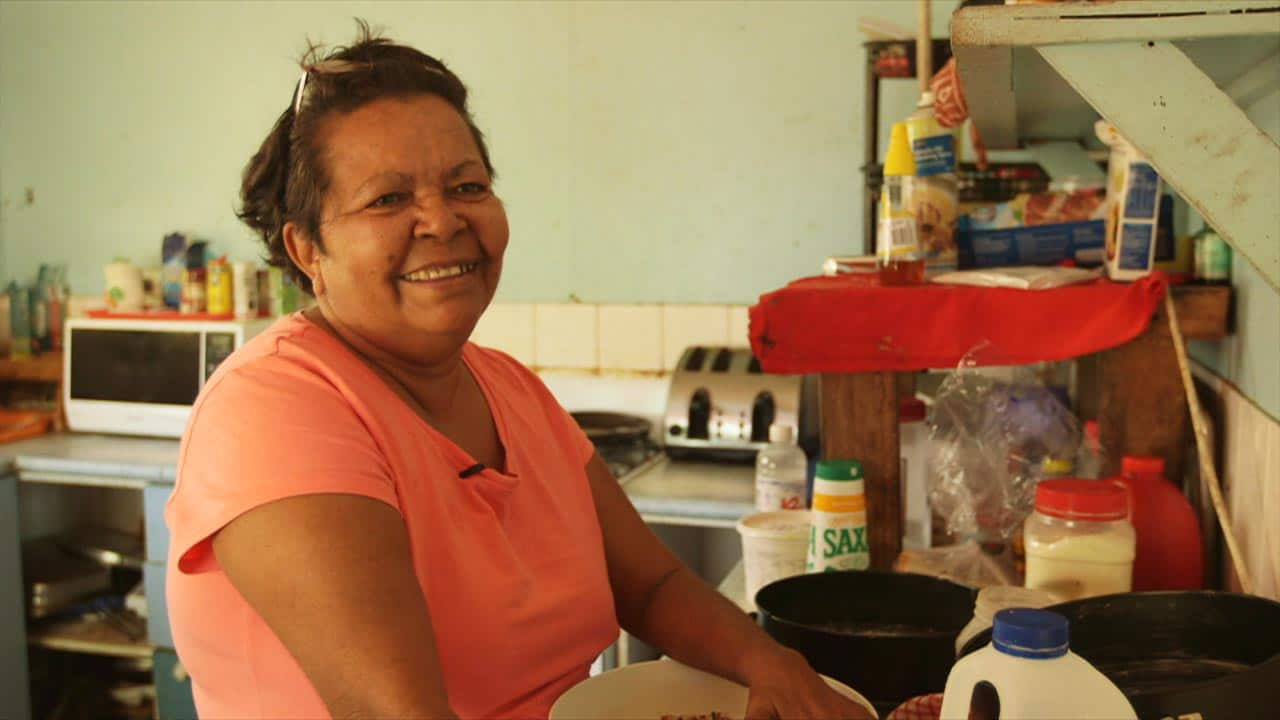Chevez was only nine years old when he was caught in the wrong place at the wrong time on his tropical island home.
"I've gotten flashbacks ... of the officer standing over me with a big assault rifle just pointing at my forehead," he recalls.
That was 12 years ago.
Watch Living Black's 'Palm Island: After the Riot'
On November 26, 2004, a protest over the death in police custody of local Indigenous man Mulrunji Doomadgee, ended with both the police station and a police officer's home being set alight. The police response saw nearly 100 armed riot police flown into Palm Island and an emergency situation declared. The next day the officers, bearing guns and wearing balaclavas, went looking for the ringleaders. The house raids began at dawn.
Chevez had snuck away from home to play hide-and-seek at a friend's house when the police stormed in. The kids scattered, but Chevez didn't run fast enough.
"They just came running in. I thought 'what the hell's going on here? They're going to shoot us all'," Chevez said.
Ordered to the ground, he looked up to see a masked policeman pointing a gun just centimetres from his face.
From that day, the child Chevez changed dramatically. For years afterwards he would wake up in the night screaming, unable to get the spectre out of his head of masked men coming to shoot him.

Children on Palm Island. Source: NITV
An island in court
On Monday 7 March, a class action resumes in the Federal Court in Townsville that sees Palm Islanders seeking damages from the Queensland Government and Police for racial discrimination.
The police force is defending its response which resulted in the raiding of 18 homes, pregnant women and children allegedly being held at gunpoint, the alleged tasing of an unarmed man and the arrests of 27 Palm Islanders.
Of those 27 arrests, 16 people were charged with various offences relating to the riot. Eleven were subsequently acquitted or had their charges dropped.
It's a pretty unique provision for a civilised country.
Stewart Levitt, the lawyer representing Palm Island in the class action, says that many of the charges involved a "unique provision" in the Queensland Criminal Code.
"A significant number of them were being charged under section 65 of the Queensland criminal code which carried a maximum penalty of life imprisonment for damage and destruction of building," Mr Levitt said.
"It's a pretty unique provision for a civilised country. It was an 1899 piece of legislation which was still being applied in Queensland."
Andrea Sailor, the Aboriginal Legal Service liaison officer on the island at the time, says many of those arrested were denied legal advice and that despite some being underage or illiterate, police elicited potentially incriminating evidence from people.
"They weren't allowing us access to our clients," she said. "I certainly lost a lot of respect with the police."

Florence Morton. Source: NITV
Legacy of distrust
Distrust of the police is still palpable on Palm Island.
"I don't open the door for police," said Chevez's mother, Florence Morton.
Among the 3,000 residents, she is not alone. "We could walk around here at night and from then on no one did," she said.
But there is a dark side to this paradise.
"You'd leave your door open, the door wasn't open anymore. So the door has been shut ever since."
These days Chevez spends most of his days fishing and hunting on an island that is a tropical paradise in the eyes of any visitor. But there is a dark side to this paradise. The sight of a police car still makes Chevez nervous. When he sees one, he walks the other way.
Work is hard to find, as the well-educated Chevez knows too well. Since 2004, the government has invested tens of millions of dollars into infrastructure on Palm Island, particularly in housing. While that has led to some local construction jobs, latest figures shows 26.3 per cent unemployment. The state average is 6.2 per cent and nearby Townsville sits at 10.5 per cent. There are few local economic drivers, with most people employed in local government, school and health services. Senior Sergeant Dave Rutherford says that descriptions of Palm Island as violent are exaggerated.
Senior Sergeant Dave Rutherford says that descriptions of Palm Island as violent are exaggerated.

Source: NITV
"Day to day we drive around the island with generally very little trouble," he said.
When asked if the people of the island trust him and the local police force, Snr Sergeant Rutherford says yes, but with the caveat "trust takes time to build."
In its season return, Living Black revisits Palm Island explore the legacy of those events from 2004.










